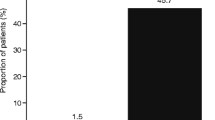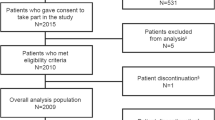Abstract
Intravenous vernakalant (Brinavess®) is an atrial-repolarization-delaying agent that is currently approved in the EU for the rapid conversion of recent-onset atrial fibrillation to sinus rhythm. Vernakalant blocks atrial-specific potassium and sodium ion channels, prolonging atrial refractory periods and rate-dependently slowing atrial conduction, without promoting ventricular arrhythmia.
In pivotal randomized, phase III trials, intravenous vernakalant 3 mg/kg administered as a 10-minute infusion, followed by a 2 mg/kg 10-minute infusion after 15 minutes if atrial fibrillation persisted, was effective in the rapid termination of recent-onset atrial fibrillation in nonsurgical patients (≥3 hours’ to ≤7 days’ duration) and in those with postoperative atrial fibrillation (3–72 hours’ duration) following cardiac surgery. Conversion to sinus rhythm occurred rapidly following infusion of vernakalant, with the majority of patients converting after the first dose, and conversion to sinus rhythm was generally associated with a rapid resolution of symptoms. These antiarrhythmic effects of vernakalant were durable, with most responders remaining in sinus rhythm 24 hours after treatment initiation. In nonsurgical patients with recent-onset atrial fibrillation of 3–48 hours’ duration, vernakalant was more effective than intravenous amiodarone, with a significantly higher proportion of patients converting to sinus rhythm within the first 90 minutes of treatment. Vernakalant was generally well tolerated in clinical trials, with most adverse events being of mild or moderate severity and not treatment limiting. Increases in QRS or QT intervals were transient, and there was no increased incidence of ventricular arrhythmia observed with vernakalant compared with placebo. Therefore, intravenous vernakalant provides an effective option for the management of recent-onset atrial fibrillation.




Similar content being viewed by others
References
Camm AJ, Kirchhof P, Lip GYH, et al. Guidelines for the management of atrial fibrillation: the task force for the management of atrial fibrillation of the European Society of Cardiology (ESC). Eur Heart J 2010; 31(19): 2369–429
Go AS, Hylek EM, Phillips KA, et al. Prevalence of diagnosed atrial fibrillation in adults: national implications for rhythm management and stroke prevention: the AnTi-coagulation and Risk Factors in Atrial Fibrillation (ATRIA) study. JAMA 2001; 285(18): 2370–5
Fuster V, Ryden LE, Cannom DS, et al. ACC/AHA/ESC 2006 guidelines for the management of patients with atrial fibrillation: a report of the American College of Cardiology/ American Heart Association Task Force on Practice Guidelines and the European Society of Cardiology Committee for Practice Guidelines (Writing Committee to Revise the 2001 Guidelines for the Management of Patients With Atrial Fibrillation): developed in collaboration with the European Heart Rhythm Association and the Heart Rhythm Society. Circulation 2006 Aug 15; 114(7): e257–354
Gallagher MM, Yap YG, Padula M, et al. Arrhythmic complications of electrical cardioversion: relationship to shock energy. Int J Cardiol 2008; 123(3): 307–12
Dobrev D, Nattel S. New antiarrhythmic drugs for treatment of atrial fibrillation. Lancet 2010 Apr 3; 375(9721): 1212–23
European Medicines Agency. Brinavess 20mg/ml, concentrate for solution for infusion: summary of product characteristics [online]. Available from URL: http://ec.europa.eu/health/documents/community-register/2010/2010090184941/anx_84941_en.pdf [Accessed 2011 Jan 17]
Camm AJ, Savelieva I. New antiarrhythmic drugs for atrial fibrillation: focus on dronedarone and vernakalant. J Intervent Card Electrophysiol 2008; 23(1): 7–14
Ehrlich JR, Biliczki P, Hohnloser SH, et al. Atrial-selective approaches for the treatment of atrial fibrillation. J Am Coll Cardiol 2008; 51(8): 787–92
Eldstrom J, Wang Z, Xu H, et al. The molecular basis of high-affinity binding of the antiarrhythmic compound vernakalant (RSD1235) to Kv1.5 channels. Mol Pharmacol 2007 Dec; 72(6): 1522–34
Wang Z, Fermini B, Nattel S. Sustained depolarization-induced outward current in human atrial myocytes: evidence for a novel delayed rectifier K+ current similar to Kv1.5 cloned channel currents. Circ Res 1993; 73(6): 1061–76
Fedida D, Wible B, Wang Z, et al. Identity of a novel delayed rectifier current from human heart with a cloned K+ channel current. Circ Res 1993; 73(1): 210–6
Fedida D, Orth PM, Chen JY, et al. The mechanism of atrial antiarrhythmic action of RSD1235. J Cardiovasc Electro-physiol 2005 Nov; 16(11): 1227–38
Orth PMR, Hesketh JC, Mak CKH, et al. RSD1235 blocks late INa and suppresses early afterdepolarizations and torsades de pointes induced by class III agents. Cardiovasc Res 2006; 70(3): 486–96
Eldstrom J, Fedida D. Modeling of high-affinity binding of the novel atrial anti-arrhythmic agent, vernakalant, to Kv1.5 channels. J Mol Graph Model 2009 Oct; 28(3): 226–35
Dorian P, Pinter A, Mangat I, et al. The effect of vernakalant (RSD1235), an investigational antiarrhythmic agent, on atrial electrophysiology in humans. J Cardiovasc Pharmacol 2007 Jul; 50(1): 35–40
Mao ZL, Gao Y, Kshirsagar S, et al. Population pharmacokinetic-pharmacodynamic analysis of vernakalant hydrochloride injection (RSD1235) in atrial fibrillation or atrial flutter [abstract no. OIII-A-I]. Clin Pharmacol Ther 2007 Mar; 81 Suppl. 1: 84
Roy D, Pratt CM, Torp-Pedersen C, et al. Vernakalant hydrochloride for rapid conversion of atrial fibrillation: a phase 3, randomized, placebo-controlled trial. Circulation 2008 Mar 25; 117(12): 1518–25
Naccarelli GV, Wolbrette DL, Samii S, et al. Vernakalant: a promising therapy for conversion of recent-onset atrial fibrillation. Expert Opin Investig Drugs 2008 May; 17(5): 805–10
European Medicines Agency. Assessment report for brinavess [online]. Available from URL: http://www.ema.europa.eu/docs/en_GB/document_library/EPAR_-_Public_assessment_report/human/001215/WC500097150.pdf [Accessed 2011 Jan 17]
Fedida D. Vernakalant (RSD1235): a novel, atrial-selective antifibrillatory agent. Expert Opin Invest Drugs 2007 Apr; 16(4): 519–32
Roy D, Rowe BH, Stiell IG, et al. A randomized, controlled trial of RSD1235, a novel anti-arrhythmic agent, in the treatment of recent onset atrial fibrillation. J Am Coll Cardiol 2004 Dec 21; 44(12): 2355–61
Cardiome Pharma Corp. A phase II/III tolerance and efficacy study of RSD1235 in patients with atrial flutter (Scene 2) [ClinicalTrials.gov identifier NCT00476112]. US National Institutes of Health, ClinicalTrials.gov [online]. Available from URL: http://www.clinicaltrials.gov [Accessed 2011 Jan 17]
Mao ZL, Wheeler JJ, Clohs L, et al. Pharmacokinetics of novel atrial-selective antiarrhythmic agent vernakalant hydrochloride injection (RSD1235): influence of CYP2D6 expression and other factors. J Clin Pharmacol 2009 Jan; 49(1): 17–29
Mao ZL, Alak A, Wheeler JJ, et al. Disposition and mass balance of 14 C-vernakalant after single intravenous and oral doses in healthy volunteers [abstract no. PII-69]. Clin Pharmacol Ther 2008 Mar 1; 83 Suppl. 1: 64
Astellas Pharma US Inc. Briefing materials for the Cardiovascular and Renal Drugs Advisory Committee, Dec 11 2007; KynapidTM (vernakalant hydrochloride injection) NDA 22-034 [online]. Available from URL: http://www.fda.gov/ohrms/dockets/ac/07/briefing/2007-4327b1-01-astellas-backgrounder.pdf [Accessed 2011 Jan 17]
Pratt CM, Roy D, Torp-Pedersen C, et al. Usefulness of vernakalant hydrochloride injection for rapid conversion of atrial fibrillation. Am J Cardiol 2010 Nov 1; 106(9): 1277–83
Camm AJ, Capucci A, Hohnloser SH, et al. A randomized active-controlled study comparing the efficacy and safety of vernakalant to amiodarone in recent-onset atrial fibrillation. J Am Coll Cardiol 2011; 57(3): 313–21
Kowey PR, Dorian P, Mitchell LB, et al. Vernakalant hydrochloride for the rapid conversion of atrial fibrillation after cardiac surgery: a randomized, double-blind, placebo-controlled trial. Circ Arrhythm Electrophysiol 2009; 2(6): 652–9
Stiell IG, Roos JS, Kavanagh KM, et al. A multicenter, open-label study of vernakalant for the conversion of atrial fibrillation to sinus rhythm. Am Heart J 2010; 159(6): 1095–101
Stiell IG, Dickinson G, Butterfield NN, et al. Vernakalant hydrochloride: a novel atrial-selective agent for the cardioversion of recent-onset atrial fibrillation in the emergency department. Acad Emerg Med 2010; 17(11): 1175–82
Cardiome Pharma Corp. Cardiome and Astellas announce receipt of FDA approvable letter for Kynapid [online]. Available from URL: http://cardiome.com/wordpress/?p=447 [Accessed 2011 Jan 17]
Mariscalco G, Klersy C, Zanobini M, et al. Atrial fibrillation after isolated coronary surgery affects late survival. Circulation 2008 Oct 14; 118(16): 1612–8
Musco S, Conway EL, Kowey PR. Drug therapy for atrial fibrillation. Med Clin North Am 2008; 92(1): 121–41
de Vos CB, Pisters R, Nieuwlaat R, et al. Progression from paroxysmal to persistent atrial fibrillation clinical correlates and prognosis. J Am Coll Cardiol 2010 Feb 23; 55(8): 725–31
Kirchhof P, Bax J, Blomstrom-Lundquist C, et al. Early and comprehensive management of atrial fibrillation: proceedings from the 2nd AFNET/EHRA consensus conference on atrial fibrillation entitled ’research perspectives in atrial fibrillation’. Europace 2009 Jul; 11(7): 860–85
Hobbs WJ, Fynn S, Todd DM, et al. Reversal of atrial electrical remodeling after cardioversion of persistent atrial fibrillation in humans. Circulation 2000 Mar 14; 101(10): 1145–51
Taylor CJ, Hodgkinson J, Hobbs FD. Rhythm control agents and adverse events in patients with atrial fibrillation. Int J Clin Pract 2010; 64(8): 1069–75
Lafuente-Lafuente C, Mahe I, Extramiana F. Management of atrial fibrillation. BMJ 2009; 340(7736): 40–5
Khan IA, Mehta NJ, Gowda RM. Amiodarone for pharmacological cardioversion of recent-onset atrial fibrillation. Int J Cardiol 2003 Jun; 89(2–3): 239–48
Crystal E, Connolly SJ, Sleik K, et al. Interventions on prevention of postoperative atrial fibrillation in patients undergoing heart surgery: a meta-analysis. Circulation 2002 Jul 2; 106(1): 75–80
Mathew JP, Fontes ML, Tudor IC, et al. A multicenter risk index for atrial fibrillation after cardiac surgery. JAMA 2004 Apr 14; 291(14): 1720–9
US National Institutes of Health. ClinicalTrials.gov [online]. Available from URL: http://www.clinicaltrials.gov [Accessed 2011 Jan 17]
Cardiome Pharma Corp. Cardiome announces suspension of enrollment in ACT 5 trial [online]. Available from URL: http://cardiome.com/wordpress/?p=563 [Accessed 2011 Jan 17]
Author information
Authors and Affiliations
Corresponding author
Additional information
Various sections of the manuscript reviewed by: D. Atar, Division of Cardiology, University of Oslo, Oslo, Norway; M. Banach, Department of Hypertension, Medical University of Lodz, Lodz, Poland; J.R. Ehrlich, Division of Cardiology, Goethe-Universität, Frankfurt, Germany; D. Fedida, Department of Anesthesiology, Pharmacology and Therapeutics and Department of Cellular and Physiological Sciences, University of British Columbia, Vancouver, British Columbia, Canada; G.Y.H. Lip, Centre for Cardiovascular Sciences, University of Birmingham, Birmingham, UK; I. Savelieva, Division of Cardiac and Vascular Sciences, St George’s University of London, London, UK.
Data Selection
Sources: Medical literature (including published and unpublished data) on ‘vernakalant’ was identified by searching databases since 1996 (including MEDLINE, EMBASE and AdisBase), bibliographies from published literature, clinical trial registries/databases and websites (including those of regional regulatory agencies and the manufacturer). Additional information (including contributory unpublished data) was also requested from the company developing the drug.
Search strategy: MEDLINE, EMBASE and AdisBase search terms were ‘vernakalant’, ‘atrial fibrillation’. Searches were last updated on 11 January 2010.
Selection: Studies in patients with recent-onset atrial fibrillation who received vernakalant. Inclusion of studies was based mainly on the methods section of the trials. When available, large, well controlled trials with appropriate statistical methodology were preferred. Relevant pharmacodynamic and pharmacokinetic data are also included.
Index terms: Vernakalant, atrial fibrillation, pharmacodynamics, pharmacokinetics, therapeutic use, tolerability.
An Erratum for this chapter can be found at http://dx.doi.org/0012-6667/11/0003-0381/$55.55/0
Various sections of the manuscript reviewed by: D. Atar, Division of Cardiology, University of Oslo, Oslo, Norway; M. Banach, Department of Hypertension, Medical University of Lodz, Lodz, Poland; J.R. Ehrlich, Division of Cardiology, Goethe-Universität, Frankfurt, Germany; D. Fedida, Department of Anesthesiology, Pharmacology and Therapeutics and Department of Cellular and Physiological Sciences, University of British Columbia, Vancouver, British Columbia, Canada; G.Y.H. Lip, Centre for Cardiovascular Sciences, University of Birmingham, Birmingham, UK; I. Savelieva, Division of Cardiac and Vascular Sciences, St George’s University of London, London, UK.
An erratum to this article is available at http://dx.doi.org/10.2165/11585420-000000000-00000.
Rights and permissions
About this article
Cite this article
Duggan, S.T., Scott, L.J. Intravenous Vernakalant. Drugs 71, 237–252 (2011). https://doi.org/10.2165/10489050-000000000-00000
Published:
Issue Date:
DOI: https://doi.org/10.2165/10489050-000000000-00000




